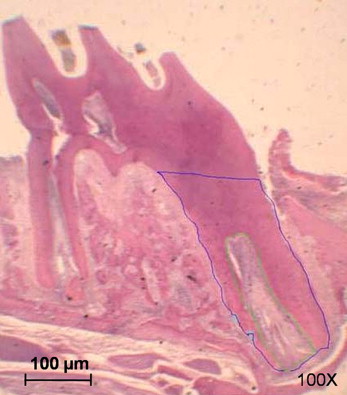Introduction
The objective of this study was to evaluate the short-term effects of clodronate, a first-generation bisphosphonate, on early alveolar bone remodeling and root resorption related to orthodontic tooth movement.
Methods
The samples consisted of 54 sex-matched Wistar rats (weight, 180-230 g) allocated to the 2.5 mmol/L clodronate, 10 mmol/L clodronate, and control groups (n = 18 for each group). After application of a nickel-titanium closed-coil spring (force, 60 g) between the maxillary central incisor and first molar, 2.5 mmol/L of clodronate, 10 mmol/L of clodronate, or saline solution was injected into the subperiosteum adjacent to the maxillary first molar every third day. All animals received tetracycline, calcein, and alizarin red by intraperitoneal injection at 1, 6, and 14 days, respectively. The amounts of tooth movement were measured at 3, 6, 9, 12, and 15 days. The animals were killed at 4, 7, and 17 days. Histomorphometric analyses of bone mineral appositional rate, labeled surface, percentage of root resorption area, and number of root resorption lacunae of the mesiobuccal root of the maxillary first molar at 4, 7, and 17 days were done. One-way analysis of variance (ANOVA) with the post-hoc test were done for statistical analyses.
Results
Rats in the 10 mmol/L clodronate group had significant decreases of tooth movement (12 and 15 days, P <0.05) and percentages of root resorption area and numbers of root resorption lacunae (7 day, P <0.05), and increases of labeled surface and mineral appositional rates (17 day, P <0.05) over those of the 2.5 mmol/L clodronate and control groups.
Conclusions
Although clodronate might decrease root resorption related to orthodontic tooth movement, patients should be informed about a possible decrease in the amount of tooth movement and a prolonged period of orthodontic treatment.
Editor’s comment
Identifying factors related to bone and or root resorption after the application of orthodontic forces remains a challenge today. The purpose of this study was to evaluate the short-term effects of clodronate, a bisphosphonate, on early alveolar bone remodeling and root resorption related to orthodontic tooth movement. Working with a sample of 54 Wistar rats, the authors gathered data using fluorescent bone markers. Designing appropriate animal studies in an attempt to eventually study the effects of bisphosphonates in humans is a daunting problem. The wish is to have basic research studies better coordinated so that they will have a greater impact on the design of future clinical human studies. According to James Zahrowski, “Our specialty needs higher evidence, which always comes from randomized controlled human trials. But, first, this needs to be started with the most appropriate animal research.”
Basic research is propagated from preceding research; however, a keen research eye must be kept on the present with the greatest potential impact from accumulated data. The findings of this study show that, whereas clodronate might decrease root resorption related to orthodontic tooth movement, patients should be informed about a possible decrease in the amount of tooth movement and a prolonged period of orthodontic treatment. This study would have been more useful clinically if alendronate, ibandronate, or zoledronic acid had been used instead of clodronate. This would open doors for human orthodontic research to further explore adverse bisphosphonate effects on tooth movement. Many more answers need to be found regarding dose-dependent and long-term changes, or how another bisphosphonate agent affects tooth movement and bone metabolism, and how this directly helps or adversely affects orthodontic treatment. In the meantime, this article will provide data for another research project.





